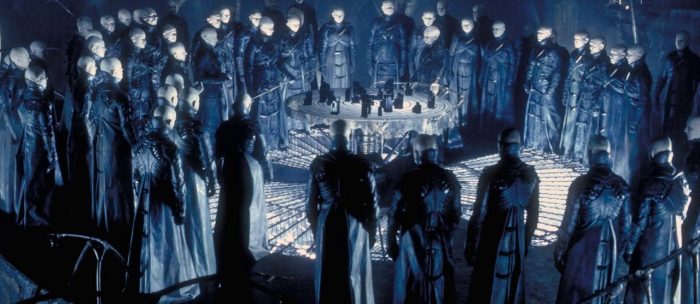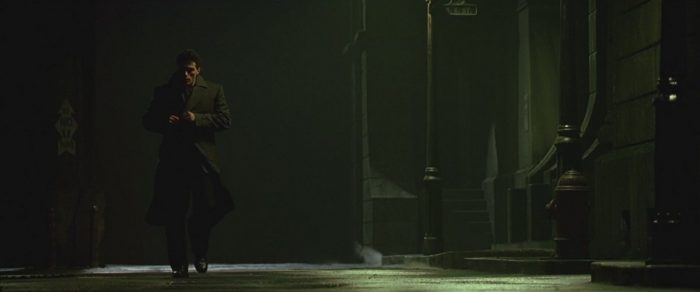Alex Proyas’ Dark City turns 20 today, a science fiction masterpiece that is at once undeniably influential in its field yet still overlooked by many fans of the genre. That commercial neglect may be due in part to the theatrical version, which opened with a studio-mandated voice-over narration that compromised Proyas’ vision – as well as that of his co-writers, Lem Dobbs and David S. Goyer – and spoiled the film’s compelling mystery before it even began.
In the theatrical version, as we sink through the cosmos into a city street bathed in night, Kiefer Sutherland’s Dr. Schreber gives us answers to questions we haven’t even thought to ask yet: “First, there was darkness. Then came The Strangers.” We learn that The Strangers are an ancient race whose inhabitants have mastered the “ultimate technology: the ability to alter physical reality by will alone.” We learn that they’re dying, that their civilization is in decline, and so they’ve abandoned their home and searched for a cure across the stars, before finding themselves on a “small blue world, in the farthest corner of the galaxy. Our world.” Although there’s still much to be learned in Dark City, the solution to its biggest riddle is handed to us in the first fifty seconds of the film.
Whereas Proyas’ superior Director’s Cut has the audience awaking into the middle of a mystery much as John Murdoch (Rufus Sewell) awakes – suddenly, perplexingly, with only our wits to give us context for what we see onscreen. Murdoch is naked, without his memories, lying in a tub in a bleak hotel bathroom. Behind the hotel bed is the butchered body of a woman, her flesh carved with concentric spirals. In this version of the film, it doesn’t yet occur to viewers that another mystery might need solving beyond the simplest, most immediate questions: who is John Murdoch? Is he responsible for the serial murders we learn are taking place across this nameless, timeless, lightless city? We have plenty of screentime to go before the epiphany that the murders are nothing more than a false flag in the midst of The Strangers’ nightly experiments on the human condition – and this knowledge is more gratifying thanks to the work we’ve done to get there.
While the ambiguity of the Director’s Cut makes for a more successful narrative approach, the theatrical version cannot hide and no voice-over can spoil the plain truth about Dark City: that this is a film of ideas, strange and fascinating and beautifully illustrated by some of the most astonishing visual effects of its time, or of the two decades that have followed. Those ideas, though original in their expression, are steeped in philosophical and psychological theories going back decades, even centuries. Dark City is a movie, in other words, that rewards you for doing your homework. Of course you can enjoy the film on its surface as an entertaining sci-fi noir, but there’s a complex nervous system running beneath this metropolis of perpetual night, a network of ideas and conceits that all aim to answer one question: what makes us human? What makes us us?
Memoirs of My Nervous Illness
Kiefer Sutherland’s character – the doctor who has reluctantly assisted The Strangers in their experiments and works to help Murdoch free humanity from their control – is named Daniel P. Schreber, after a German judge who suffered from paranoid schizophrenia and wrote about his experience in an asylum. Daniel Paul Schreber’s Memoirs of My Nervous Illness is a revelatory psychological text because Schreber wrote it both during and after bouts of madness, with insight into his own affliction that no external party could ever offer. Freud and Jung were both fascinated by the book and its author, with Freud suggesting, “The wonderful Schreber…ought to have been made a professor of psychiatry and director of a mental hospital” (from the book’s intro, written by Rosemary Dinnage).
Much has been made of Schreber’s description of “fleetingly-improvised men” as an influence on Dark City – transient human shapes that occasionally resemble dead people and whose existence is fleeting and immaterial. It’s a pretty good description of The Strangers, but the connection between Memoirs of My Nervous Illness and Dark City goes beyond their shared villains into the very substance (or lack of substance) of their worlds. As Dinnage says, “The Memoirs are an account of what it is to be forsaken by everything familiar and real, and of the delusionary world that gets invented in its place.” Every night at midnight in the Dark City, a delusionary world is invented, keeping its inhabitants from the comfort of familiarity or reality.
Meanwhile, Schreber writes of God’s egoism – “particularly in the form of the instinct of self-preservation, which at times demands the sacrifice of other beings for one’s own existence.” The Strangers are the gods of Dark City’s universe, and they sacrifice human memory and personality in the search for their own preserved existence. They even use our dead as their vessels, quite literally sacrificing other beings for their own self-preservation.
Memoirs of My Nervous Illness has a LOT to it – it’s one of the most fascinating books on psychology ever written, and reading it reveals dozens of slighter influences on Dark City. Schreber is not only represented in the film by Sutherland’s character, through his name and his quest for answers, but also by Murdoch, who has lost his identity and, in searching for it, becomes capable of great feats of supernatural power, as Schreber in his delusion believed of himself. And he’s represented by the mad, retired Detective Eddie Walenski (Colin Friels), in his desperate certainty that the world around him is wrong, even if no one else can see it. Daniel Paul Schreber is in every word and idea behind Dark City, a film that is as much about the search for self as it is about bald aliens and murdered prostitutes.
Continue Reading Dark City Anniversary >>
The post 20 Years Later, ‘Dark City’ Remains One of the Smartest Sci-Fi Films Ever Made appeared first on /Film.
from /Film http://ift.tt/2HPoSpq


No comments:
Post a Comment